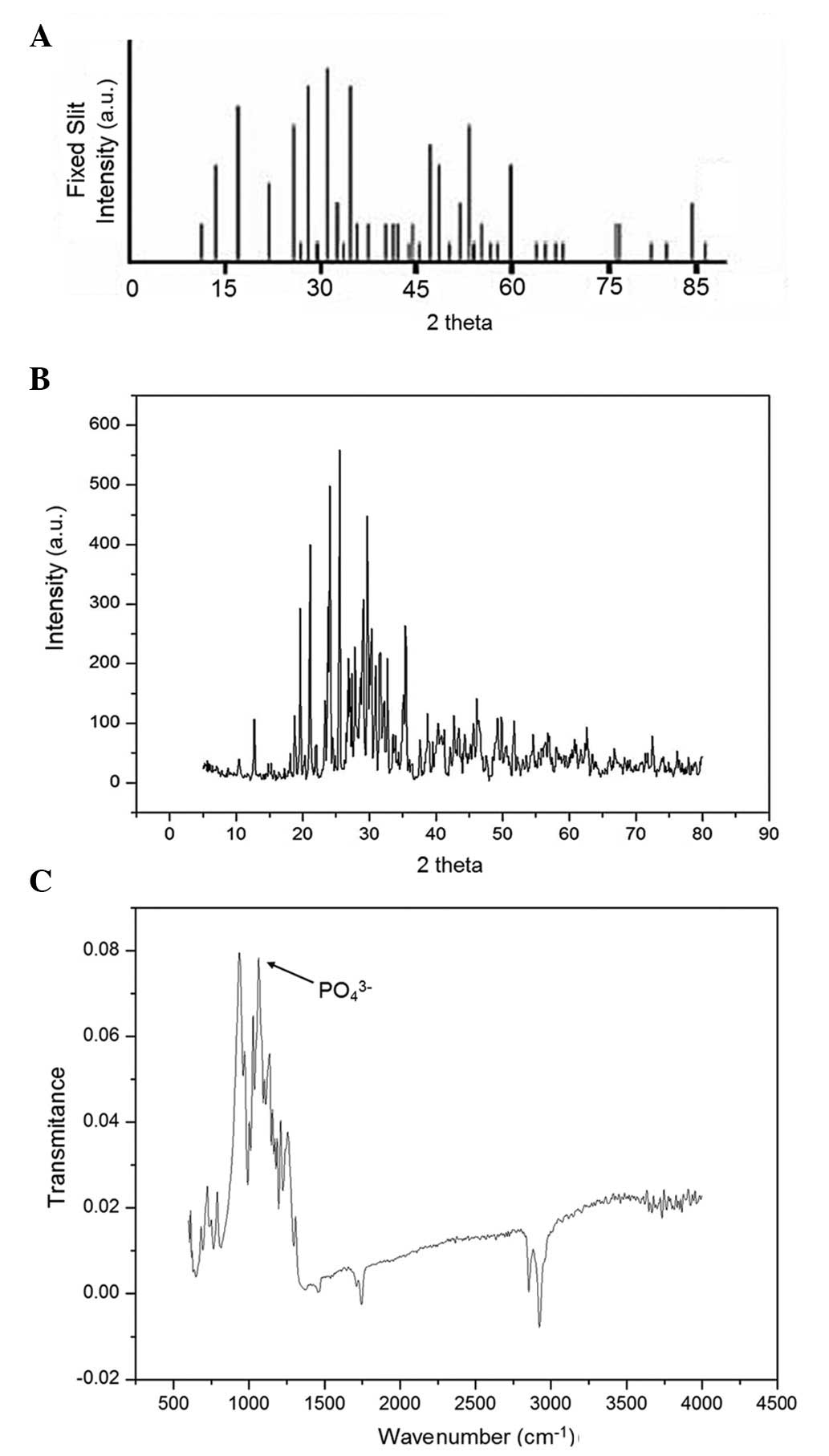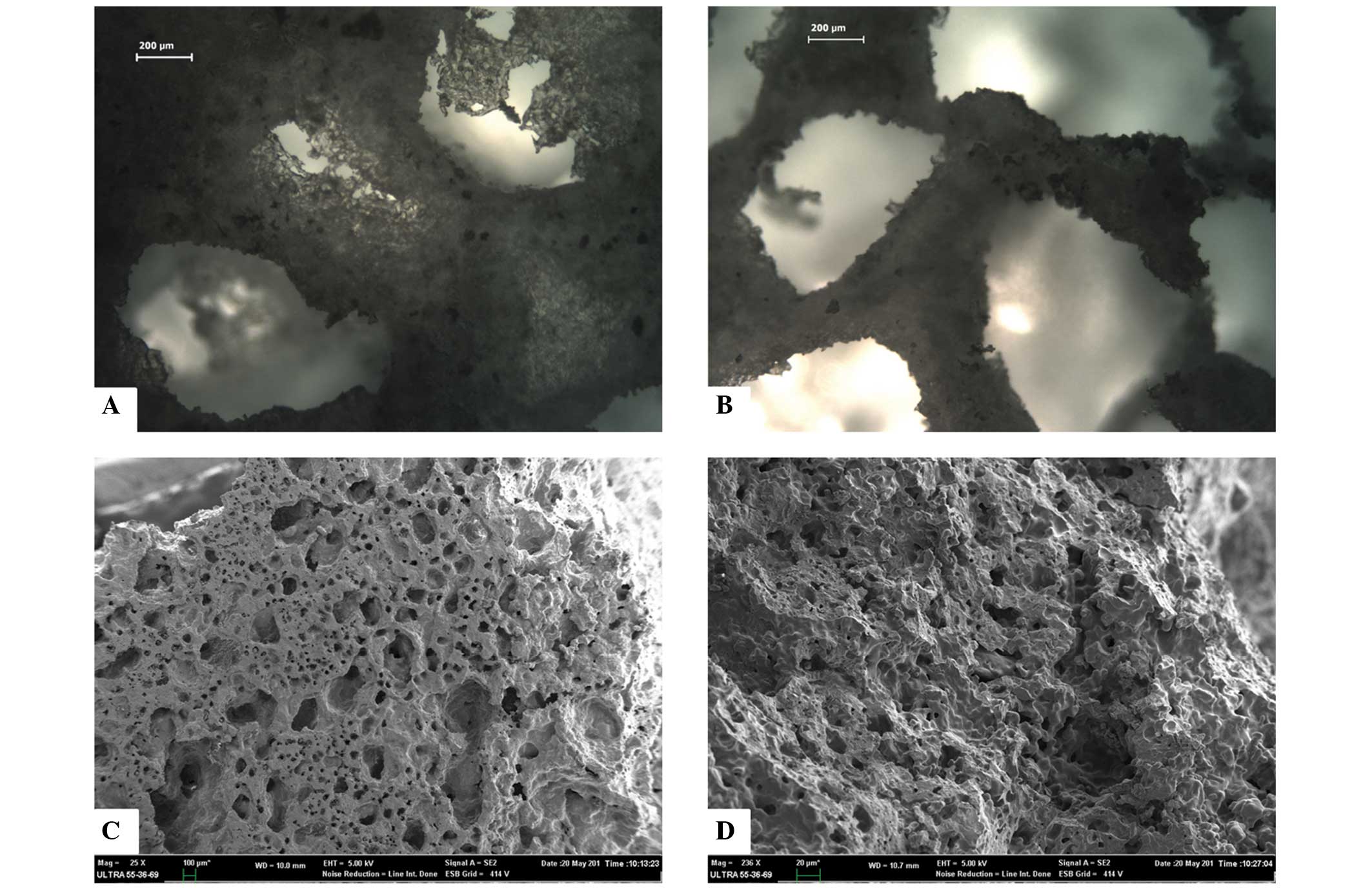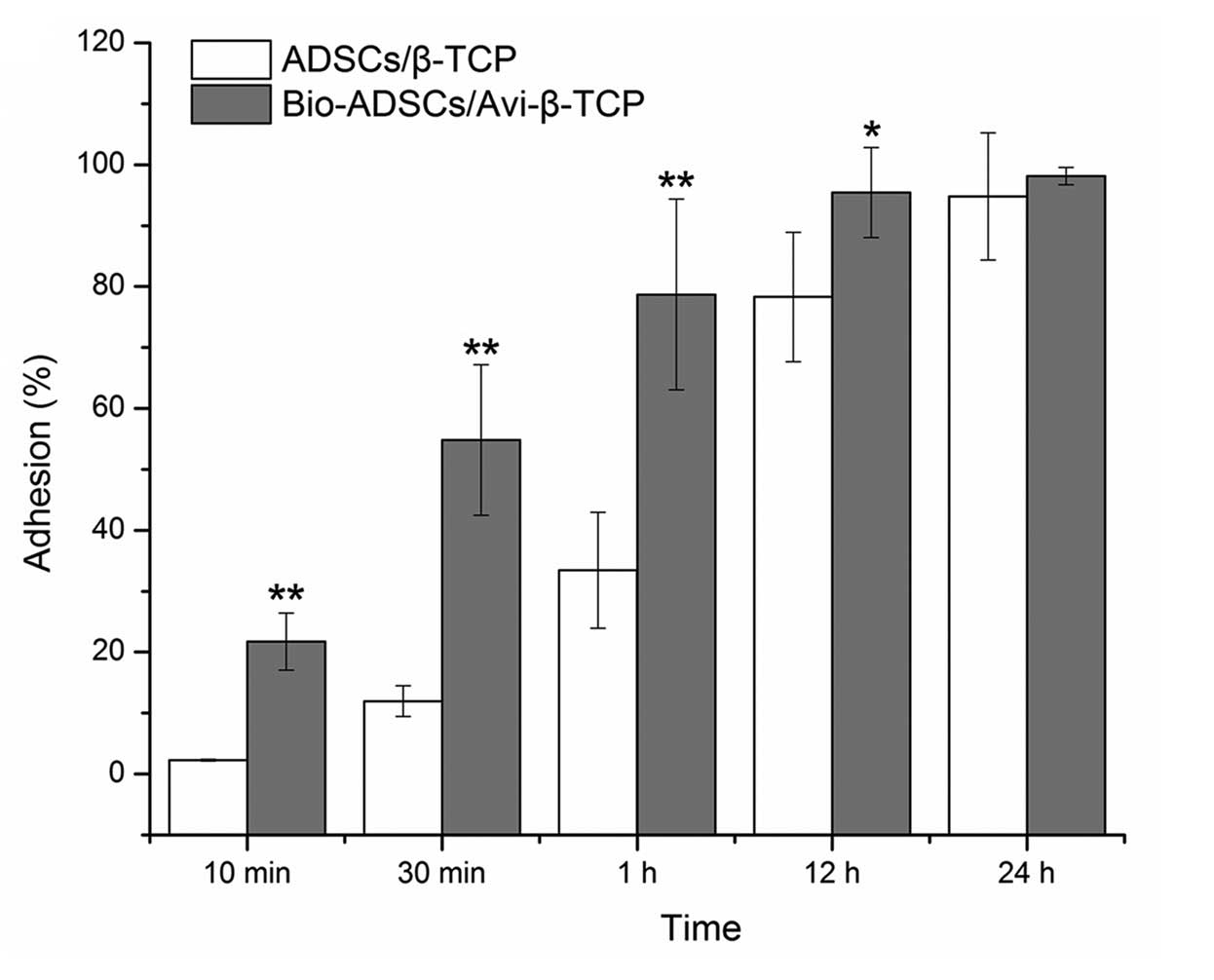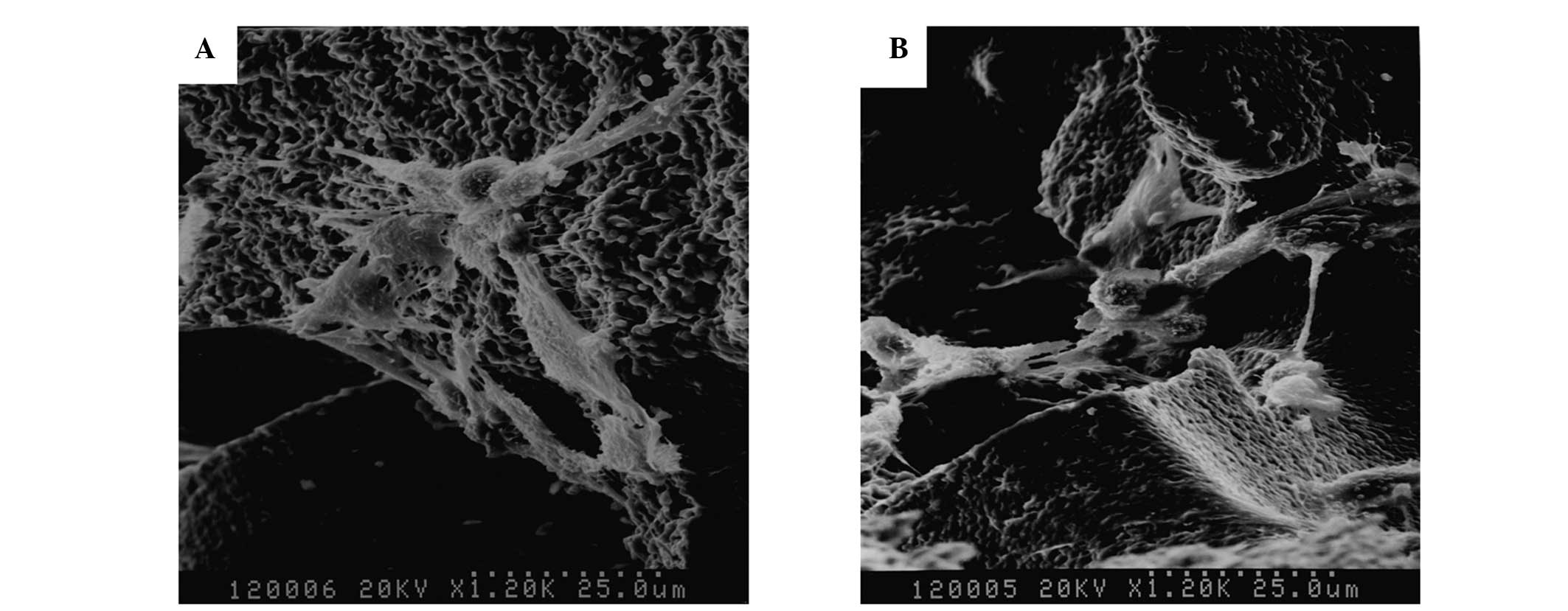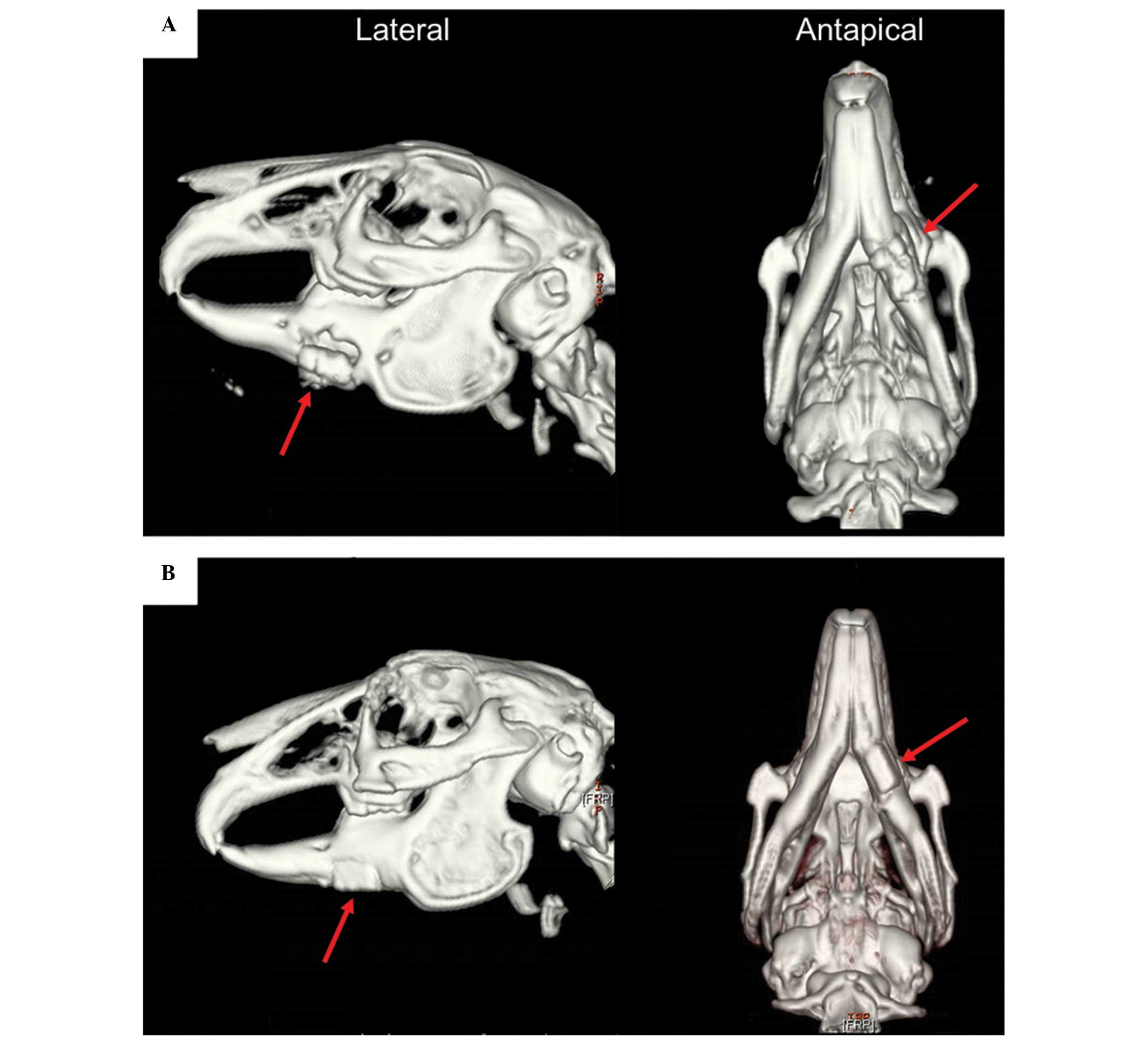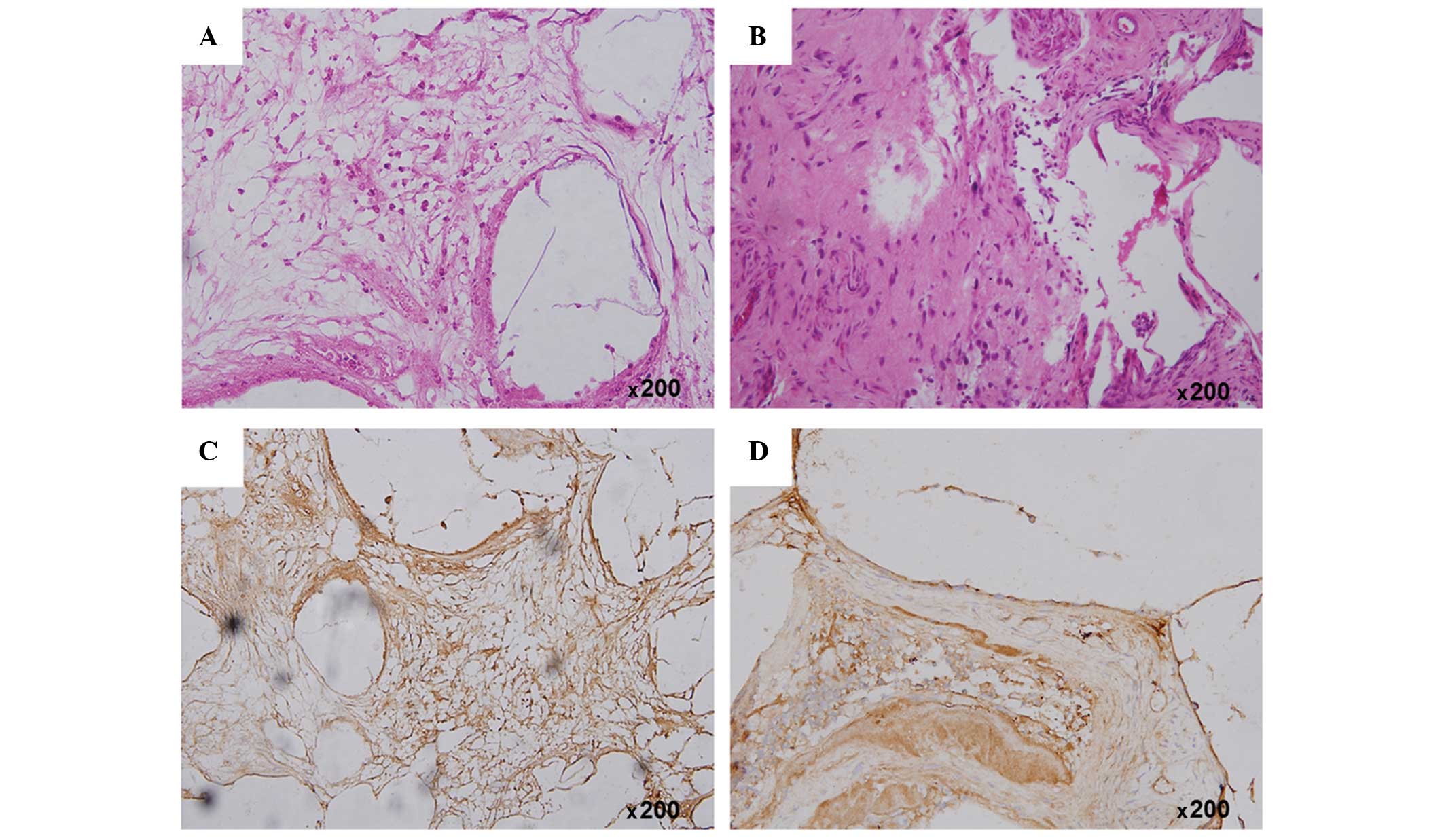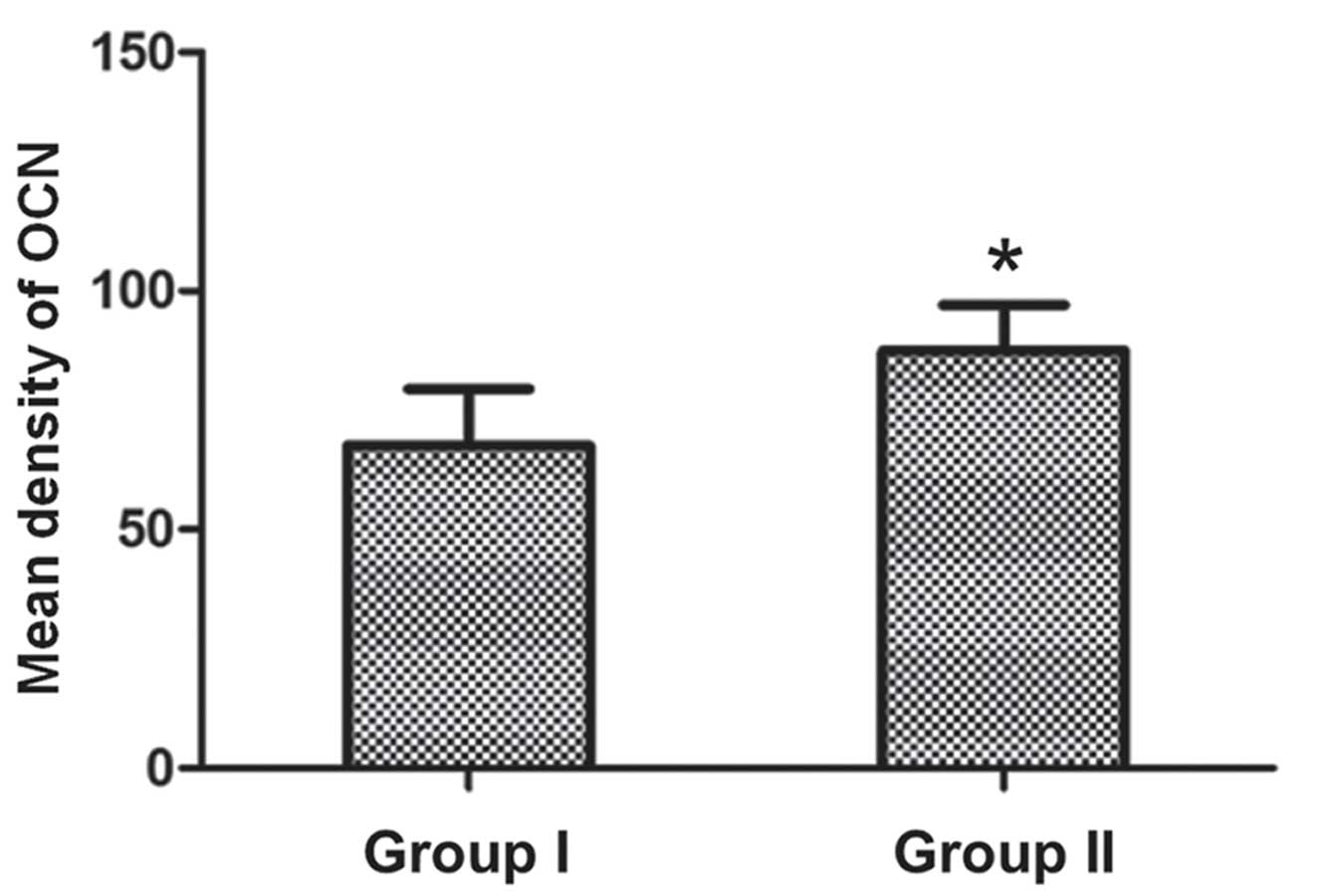|
1
|
Damaraju S and Duncan NA: Stem cell-based
tissue engineering for bone repair. Tissue Engineering. Fernandes
PR and Bartolo PJ: 31:(Dordrecht, The Netherlands). Springer. 1–30.
2014. View Article : Google Scholar
|
|
2
|
Liu Y, Zhou Y, Feng H, Ma GE and Ni Y:
Injectable tissue-engineered bone composed of human adipose-derived
stromal cells and platelet-rich plasma. Biomaterials. 29:3338–3345.
2008. View Article : Google Scholar : PubMed/NCBI
|
|
3
|
Buser Z, Liu J, Thorne KJ, Coughlin D and
Lotz JC: Inflammatory response of intervertebral disc cells is
reduced by fibrin sealant scaffold in vitro. J Tissue Eng Regen
Med. 8:77–84. 2014. View Article : Google Scholar : PubMed/NCBI
|
|
4
|
Ravichandran R, Venugopal JR, Sundarrajan
S, Mukherjee S and Ramakrishna S: Precipitation of
nanohydroxyapatite on PLLA/PBLG/Collagen nanofibrous structures for
the differentiation of adipose derived stem cells to osteogenic
lineage. Biomaterials. 33:846–855. 2012. View Article : Google Scholar : PubMed/NCBI
|
|
5
|
Chang NJ, Lam CF, Lin CC, Chen WL, Li CF,
Lin YT and Yeh ML: Transplantation of autologous endothelial
progenitor cells in porous PLGA scaffolds create a microenvironment
for the regeneration of hyaline cartilage in rabbits.
Osteoarthritis Cartilage. 21:1613–1622. 2013. View Article : Google Scholar : PubMed/NCBI
|
|
6
|
Szpalski C, Barbaro M, Sagebin F and
Warren SM: Bone tissue engineering: Current strategies and
techniques - part. II Cell types. Tissue Eng Part B Rev.
18:258–269. 2012. View Article : Google Scholar : PubMed/NCBI
|
|
7
|
Khaled EG, Saleh M, Hindocha S, Griffin M
and Khan WS: Tissue engineering for bone production-stem cells,
gene therapy and scaffolds. Open Orthop J. 5(Suppl 2): S289–S295.
2011. View Article : Google Scholar
|
|
8
|
Cha C, Liechty WB, Khademhosseini A and
Peppas NA: Designing biomaterials to direct stem cell fate. ACS
Nano. 6:9353–9358. 2012. View Article : Google Scholar : PubMed/NCBI
|
|
9
|
Mosna F, Sensebé L and Krampera M: Human
bone marrow and adipose tissue mesenchymal stem cells: A user's
guide. Stem Cells Dev. 19:1449–1470. 2010. View Article : Google Scholar : PubMed/NCBI
|
|
10
|
Farzadi A, Solati-Hashjin M, Bakhshi F and
Aminian A: Synthesis and characterization of
hydroxyapatite/β-tricalcium phosphate nanocomposites using
microwave irradiation. Ceram Int. 37:65–71. 2011. View Article : Google Scholar
|
|
11
|
Kolk A, Handschel J, Drescher W, Rothamel
D, Kloss F, Blessmann M, Heiland M, Wolff KD and Smeets R: Current
trends and future perspectives of bone substitute materials - from
space holders to innovative biomaterials. J Craniomaxillofac Surg.
40:706–718. 2012. View Article : Google Scholar : PubMed/NCBI
|
|
12
|
Miyaji H, Yokoyama H, Kosen Y, Nishimura
H, Nakane K, Tanaka S, Otani K, Inoue K, Ibara A, Kanayama I, et
al: Bone augmentation in rat by highly porous β-TCP scaffolds with
different open-cell sizes in combination with fibroblast growth
factor-2. J Oral Tissue Engin. 10:172–181. 2013.
|
|
13
|
Zheng H, Bai Y, Shih MS, Hoffmann C,
Peters F, Waldner C and Hübner WD: Effect of a β-TCP collagen
composite bone substitute on healing of drilled bone voids in the
distal femoral condyle of rabbits. J Biomed Mater Res B Appl
Biomater. 102:376–383. 2014. View Article : Google Scholar : PubMed/NCBI
|
|
14
|
Rezwan K, Chen QZ, Blaker JJ and
Boccaccini AR: Biodegradable and bioactive porous polymer/inorganic
composite scaffolds for bone tissue engineering. Biomaterials.
27:3413–3431. 2006. View Article : Google Scholar : PubMed/NCBI
|
|
15
|
Choi D and Kumta PN: Mechano-chemical
synthesis and characterization of nanostructured β-TCP powder.
Materials Science and Engineering: C. 27:377–381. 2007. View Article : Google Scholar
|
|
16
|
Griffin M, Iqbal S and Bayat A: Exploring
the application of mesenchymal stem cells in bone repair and
regeneration. J Bone Joint Surg Br. 93:427–434. 2011. View Article : Google Scholar : PubMed/NCBI
|
|
17
|
Cao H and Kuboyama N: A biodegradable
porous composite scaffold of PGA/beta-TCP for bone tissue
engineering. Bone. 46:386–395. 2010. View Article : Google Scholar : PubMed/NCBI
|
|
18
|
Guasti L, Prasongchean W, Kleftouris G,
Mukherjee S, Thrasher AJ, Bulstrode NW and Ferretti P: High
plasticity of pediatric adipose tissue-derived stem cells: Too much
for selective skeletogenic differentiation? Stem Cells Transl Med.
1:384–395. 2012. View Article : Google Scholar : PubMed/NCBI
|
|
19
|
Levi B and Longaker MT: Concise review:
Adipose-derived stromal cells for skeletal regenerative medicine.
Stem Cells. 29:576–582. 2011. View
Article : Google Scholar : PubMed/NCBI
|
|
20
|
Zuk PA, Zhu M, Mizuno H, Huang J, Futrell
JW, Katz AJ, Benhaim P, Lorenz HP and Hedrick MH: Multilineage
cells from human adipose tissue: Implications for cell-based
therapies. Tissue Eng. 7:211–228. 2001. View Article : Google Scholar : PubMed/NCBI
|
|
21
|
Zuk PA, Zhu M, Ashjian P, De Ugarte DA,
Huang JI, Mizuno H, Alfonso ZC, Fraser JK, Benhaim P and Hedrick
MH: Human adipose tissue is a source of multipotent stem cells. Mol
Biol Cell. 13:4279–4295. 2002. View Article : Google Scholar : PubMed/NCBI
|
|
22
|
Liao HT, Chen JP and Lee MY: Bone tissue
engineering with adipose-derived stem cells in bioactive composites
of laser-sintered porous polycaprolactone scaffolds and
platelet-rich plasma. Materials. 6:4911–4929. 2013. View Article : Google Scholar
|
|
23
|
Fang X, Murakami H, Demura S, Hayashi K,
Matsubara H, Kato S, Yoshioka K, Inoue K, Ota T, Shinmura K and
Tsuchiya H: A novel method to apply osteogenic potential of adipose
derived stem cells in orthopaedic surgery. PloS One. 9:e888742014.
View Article : Google Scholar : PubMed/NCBI
|
|
24
|
Ahn HH, Kim KS, Lee JH, Lee JY, Kim BS,
Lee IW, Chun HJ, Kim JH, Lee HB and Kim MS: In vivo osteogenic
differentiation of human adipose-derived stem cells in an
injectable in situ-forming gel scaffold. Tissue Eng Part A.
15:1821–1832. 2009. View Article : Google Scholar : PubMed/NCBI
|
|
25
|
Grottkau BE and Lin Y: Osteogenesis of
adipose-derived stem cells. Bone Res. 1:133–145. 2013. View Article : Google Scholar : PubMed/NCBI
|
|
26
|
Rehman J, Traktuev D, Li J, Merfeld-Clauss
S, Temm-Grove CJ, Bovenkerk JE, Pell CL, Johnstone BH, Considine RV
and March KL: Secretion of angiogenic and antiapoptotic factors by
human adipose stromal cells. Circulation. 109:1292–1298. 2004.
View Article : Google Scholar : PubMed/NCBI
|
|
27
|
Liao HT and Chen CT: Osteogenic potential:
Comparison between bone marrow and adipose-derived mesenchymal stem
cells. World J Stem Cells. 6:288–295. 2014. View Article : Google Scholar : PubMed/NCBI
|
|
28
|
Nurden AT: Platelets, inflammation and
tissue regeneration. Thromb Haemost. 105(Suppl 1): S13–S33. 2011.
View Article : Google Scholar : PubMed/NCBI
|
|
29
|
Nurden AT, Nurden P, Sanchez M, Andia I
and Anitua E: Platelets and wound healing. Front Biosci.
13:3532–3548. 2008.
|
|
30
|
Marx RE: Platelet-rich plasma: Evidence to
support its use. J Oral Maxillofac Surg. 62:489–496. 2004.
View Article : Google Scholar : PubMed/NCBI
|
|
31
|
Marx RE, Carlson ER, Eichstaedt RM,
Schimmele SR, Strauss JE and Georgeff KR: Platelet-rich plasma:
Growth factor enhancement for bone grafts. Oral Surg Oral Med Oral
Pathol Oral Radiol Endod. 85:638–646. 1998. View Article : Google Scholar : PubMed/NCBI
|
|
32
|
Niemeyer P, Fechner K, Milz S, Richter W,
Suedkamp NP, Mehlhorn AT, Pearce S and Kasten P: Comparison of
mesenchymal stem cells from bone marrow and adipose tissue for bone
regeneration in a critical size defect of the sheep tibia and the
influence of platelet-rich plasma. Biomaterials. 31:3572–3579.
2010. View Article : Google Scholar : PubMed/NCBI
|
|
33
|
Mazzocca AD, McCarthy MB, Chowaniec DM,
Dugdale EM, Hansen D, Cote MP, Bradley JP, Romeo AA, Arciero RA and
Beitzel K: The positive effects of different platelet-rich plasma
methods on human muscle, bone and, tendon cells. Am J Sports Med.
40:1742–1749. 2012. View Article : Google Scholar : PubMed/NCBI
|
|
34
|
El Backly RM, Zaky SH, Muraglia A,
Tonachini L, Brun F, Canciani B, Chiapale D, Santolini F, Cancedda
R and Mastrogiacomo M: A platelet-rich plasma-based membrane as a
periosteal substitute with enhanced osteogenic and angiogenic
properties: properties = A platelet-rich plasma-based membrane as a
periosteal substitute with enhanced osteogenic and angiogenic
properties: A new concept for bone repair. Tissue Eng Part A.
19:152–165. 2013. View Article : Google Scholar : PubMed/NCBI
|
|
35
|
Wang C, Zhong D, Zhou X, Yin K, Liao Q,
Kong L and Liu A: Preparation of a new composite combining
strengthened β-tricalcium phosphate with platelet-rich plasma as a
potential scaffold for the repair of bone defects. Exp Ther Med.
8:1081–1086. 2014.PubMed/NCBI
|
|
36
|
Mirhadi B, Mehdikhani B and Askari N:
Synthesis of nano-sized β-tricalcium phosphate via wet
precipitation. Processing and Application of Ceramics. 5:193–198.
2011. View Article : Google Scholar
|
|
37
|
Monshi A, Foroughi MR and Monshi MR:
Modified Scherrer equation to estimate more accurately
nano-crystallite size using XRD. World J Nano Sci Eng. 2:1542012.
View Article : Google Scholar
|
|
38
|
Tran RT, Thevenot P, Zhang Y, Gyawali D,
Tang L and Yang J: Scaffold sheet design strategy for soft tissue
engineering. Nat Mater. 3:1375–1389. 2010. View Article : Google Scholar : PubMed/NCBI
|
|
39
|
American Society of the International
Association for Testing and Materials (ASTM) International: ASTM
Standard D695-91: Standard test method for compressive properties
of rigid plastics. Annual Book of ASTM Standards (8th). (West
Conshohocken, PA). ASTM International. 204–210. 1993.
|
|
40
|
Jeong SM, Lee CU, Son JS, Oh JH, Fang Y
and Choi BH: Simultaneous sinus lift and implantation using
platelet-rich fibrin as sole grafting material. J Craniomaxillofac
Surg. 42:990–994. 2014. View Article : Google Scholar : PubMed/NCBI
|
|
41
|
Schneider CA, Rasband WS and Eliceiri KW:
NIH Image to ImageJ: 25 years of image analysis. Nat Methods.
9:671–675. 2012. View Article : Google Scholar : PubMed/NCBI
|
|
42
|
Schmittgen TD and Livak KJ: Analyzing
real-time PCR data by the comparative C(T) method. Nat Protoc.
3:1101–1108. 2008. View Article : Google Scholar : PubMed/NCBI
|
|
43
|
Frondel C: Mineralogy of the calcium
phosphates in insular phosphate rock. Am Mineral. 28:215–232.
1943.
|
|
44
|
Yuan H, Yang Z, De Bruij JD, De Groot K
and Zhang X: Material-dependent bone induction by calcium phosphate
ceramics: A 2.5-year study in dog. Biomaterials. 22:2617–2623.
2001. View Article : Google Scholar : PubMed/NCBI
|
|
45
|
Okamoto M, Dohi Y, Ohgushi H, Shimaoka H,
Ikeuchi M, Matsushima A, Yonemasu K and Hosoi H: Influence of the
porosity of hydroxyapatite ceramics on in vitro and in vivo bone
formation by cultured rat bone marrow stromal cells. J Mater Sci
Mater Med. 17:327–336. 2006. View Article : Google Scholar : PubMed/NCBI
|
|
46
|
Annaz B, Hing K, Kayser M, Buckland T and
Di Silvio L: Porosity variation in hydroxyapatite and osteoblast
morphology: A scanning electron microscopy study. J Microsc.
215:100–110. 2004. View Article : Google Scholar : PubMed/NCBI
|
|
47
|
Karageorgiou V and Kaplan D: Porosity of
3D biomaterial scaffolds and osteogenesis. Biomaterials.
26:5474–5491. 2005. View Article : Google Scholar : PubMed/NCBI
|
|
48
|
Hulbert SF, Young FA, Mathews RS,
Klawitter JJ, Talbert CD and Stelling FH: Potential of ceramic
materials as permanently implantable skeletal prostheses. J Biomed
Mater Res. 4:433–456. 1970. View Article : Google Scholar : PubMed/NCBI
|
|
49
|
Yuan J, Cui L, Zhang WJ, Liu W and Cao YL:
Repair of canine mandibular bone defects with bone marrow stromal
cells and porous β-tricalcium phosphate. Biomaterials. 6:1005–1013.
2007. View Article : Google Scholar
|
|
50
|
Kasemo B: Biological surface science. Surf
Sci. 500:656–677. 2002. View Article : Google Scholar
|
|
51
|
Tsai WB and Wang MC: Effects of an
avidin-biotin binding system on chondrocyte adhesion and growth on
biodegradable polymers. Macromol Biosci. 5:214–221. 2005.
View Article : Google Scholar : PubMed/NCBI
|
|
52
|
Balcells M and Edelman ER: Effect of
pre-adsorbed proteins on attachment, proliferation, and function of
endothelial cells. J Cell Physiol. 191:155–161. 2002. View Article : Google Scholar : PubMed/NCBI
|
|
53
|
Massia SP and Hubbell JA: Human
endothelial cell interactions with surface-coupled adhesion
peptides on a nonadhesive glass substrate and two polymeric
biomaterials. J Biomed Mater Res. 25:223–242. 1991. View Article : Google Scholar : PubMed/NCBI
|
|
54
|
Dekker A, Poot AA, van Mourik JA, Workel
MP, Beugeling T, Bantjes A, Feijen J and Van Aken WG: Improved
adhesion and proliferation of human endothelial cells on
polyethylene precoated with monoclonal antibodies directed against
cell membrane antigens and extracellular matrix proteins. Thromb
Haemost. 66:715–724. 1991.PubMed/NCBI
|
|
55
|
Sinclair J and Salem AK: Rapid localized
cell trapping on biodegradable polymers using cell surface
derivatization and microfluidic networking. Biomaterials.
27:2090–2094. 2006. View Article : Google Scholar : PubMed/NCBI
|
|
56
|
Bhat V, Truskey G and Reichert WM: Using
avidin-mediated binding to enhance initial endothelial cell
attachment and spreading. J Biomed Mater Res. 40:57–65. 1998.
View Article : Google Scholar : PubMed/NCBI
|
|
57
|
Poeschl PW, Ziya-Ghazvini F, Schicho K,
Buchta C, Moser D, Seemann R, Ewers R and Schopper C: Application
of platelet-rich plasma for enhanced bone regeneration in grafted
sinus. J Oral Maxillofac Surg. 70:657–664. 2012. View Article : Google Scholar : PubMed/NCBI
|
|
58
|
Albanese A, Licata ME, Polizzi B and
Campisi G: Platelet-rich plasma (PRP) in dental and oral surgery:
From the wound healing to bone regeneration. Immun Ageing.
10:232013. View Article : Google Scholar : PubMed/NCBI
|
|
59
|
Khairy N, Shendy E, Askar N and El-Rouby
DH: Effect of platelet rich plasma on bone regeneration in
maxillary sinus augmentation (randomized clinical trial). Int J
Oral Maxillofac Surg. 42:249–255. 2013. View Article : Google Scholar : PubMed/NCBI
|
|
60
|
Mifune Y, Matsumoto T, Takayama K, Ota S,
Li H, Meszaros LB, Usas A, Nagamune K, Gharaibeh B, Fu FH and Huard
J: The effect of platelet-rich plasma on the regenerative therapy
of muscle derived stem cells for articular cartilage repair.
Osteoarthritis Cartilage. 21:175–185. 2013. View Article : Google Scholar : PubMed/NCBI
|
|
61
|
Sun Y, Feng Y, Zhang CQ, Chen SB and Cheng
XG: The regenerative effect of platelet-rich plasma on healing in
large osteochondral defects. Int Orthop. 34:589–597. 2010.
View Article : Google Scholar : PubMed/NCBI
|
|
62
|
Intini G: The use of platelet-rich plasma
in bone reconstruction therapy. Biomaterials. 30:4956–4966. 2009.
View Article : Google Scholar : PubMed/NCBI
|















